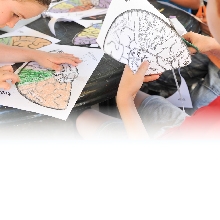Protein “scaffolding” made simple
New research by Dr. Emmanuel Levy
Briefs

Proteins are the building blocks of life. But single genetic mutations can cause proteins to deviate from their normal assembly plan.
Such is the case with sickle-cell disease—a condition which affects 4.4 million people worldwide, mostly of African origin—in which a single mutation triggers the self-assembly of hemoglobin into long, stiff filaments that elongate red blood cells and impair their function.
Now, a Weizmann Institute team has shown how proteins that are symmetrical in structure, like hemoglobin, are highly predisposed to stack together in multi-protein assemblies. The team’s experimental results—which were published in Nature and have implications for both human health and bio-based nanotechnology—demonstrate how an entire category of proteins is prone to dramatic transformation in response to the smallest genetic change. Such proteins, in other words, live their lives on the evolutionary “edge”.
The finding provides new insight about the ease with which protein fibers self-assemble in conditions such as sickle-cell disease. It also indicates that protein-based fibers based on self-assembling symmetric units could contribute to nanotechnology: they could eventually be used as scaffolds in new, synthetic materials.
According to Dr. Emmanuel Levy of the Department of Structural Biology, who led the study, protein self-assembly depends on a specific geometrical characteristic: symmetry. Symmetric protein complexes are made of identical units; since these units are produced from the same gene, a single genetic mutation will be repeated multiple times in the complex. At each point in which the mutation occurs, a uniform change in structure appears as well, creating a matched set of “LEGO-like” protein building blocks, capable of fitting together exactly.
However, while their structural symmetry enables such proteins to stack together, maintaining the integrity of very large assemblies is a stickier problem—pun intended: Dr. Levy introduced a specific type of mutation—one that transforms the proteins’ outer surfaces into something sticky, thereby making the proteins stably stackable.
“In our study, we created protein-to-protein adhesion spots by introducing mutations that exchanged one amino acid that is normally hydrophilic—water-loving—with one that is hydrophobic, or water hating,” Dr. Levy explains. “Hydrophobic regions prefer to interact with one another, like soap bubbles stick together in water. While this hydrophobic effect is well known, it has long been believed to stem from a number of interrelated factors. Unexpectedly, however, our experiments proved that a single mutation—one that produceshydrophobicity—is often sufficient to trigger the production of self-assembling, stable protein filaments.”
Dr. Levy and his group, including Hector Garcia-Seisdedos, Charly Empereur-Mot (now at Conservatoire National des Arts et Métiers in Paris) and Nadav Elad of the Weizmann Institute’s Department of Chemical Research Support, initially worked with an ultra-symmetric protein complex made up of eight identical units. They switched one hydrophilic amino acid for a hydrophobic, “sticky,” one, and confirmed the resulting self-assembly using electron microscopy. Later, the team mutated 11 additional proteins known to be symmetrical—creating 73 different mutations in all—and introduced them into baker’s yeast cells, adding a fluorescent protein “label” to enable their visualization.
Filming the yeast cells as they grew, the researchers found that, in 30 of these variations, self-assembly occurred. Of these, half had stacked into filaments, similar to what is seen in sickle-cell disease, while the other half bunched together in a more amorphous way. Such amorphous assemblies are often dismissed as artifacts of misfolded proteins. However, Dr. Levy’s discovery that such assemblies evolve easily, requiring only a single or few point mutations, means that they may be more prevalent and biologically important than was previously assumed.
“Our approach required no complex computational design, nor did we need to scan thousands of mutations to find the one we wanted,” Dr. Levy says. “We simply started with an existing structure and found a simple strategy to induce the assembly of filaments. Now we are continuing to research this phenomenon to understand exactly how it happens in nature as well as in artificially mutated proteins.”
Dr. Emmanuel Levy is supported by the David and Fela Shapell Family Foundation INCPM Fund for Preclinical Studies, the Henry Chanoch Krenter Institute for Biomedical Imaging and Genomics, the Louis and Fannie Tolz Collaborative Research Project, the Richard Bar Laboratory, and Anne-Marie Boucher and Mitch Garber of Canada. Dr. Levy is the incumbent of the Recanati Career Development Chair of Cancer Research in Perpetuity.








